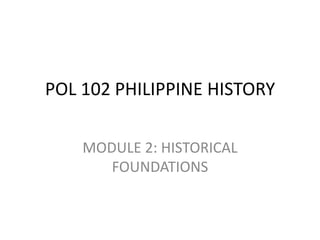Module 2 historical foundation
- 1. POL 102 PHILIPPINE HISTORY MODULE 2: HISTORICAL FOUNDATIONS
- 2. OBJECTIVES: ŌĆó 1. Discuss the various theories on Philippine evolution. ŌĆó 2. Identify the distinct traits of Filipinos different from the people of other neighbouring countries. ŌĆó 3. Look for something indigenous/ cultural value and show it in the class.
- 3. A. Origin of the Philippines ŌĆó 1. Land bridge theory- according to this theory, the earth is was made up of huge landmasses that connected each piece of land to one another through land bridges located above big bodies of water
- 4. ŌĆó 2. Big Bang theory- a massive explosion from within the landmass are believed to have been origin of the present-day countries including the Philippines
- 5. ŌĆó 3. Biblical Theory-this theory states that God created heaven and earth, after which the first man and woman named Adam and Eve. It was from these two living creatures of God that various races sprouted.
- 6. ŌĆó 4. Darwinian Theory-traces manŌĆÖs origin from apes, the ancestors of man (homo erectus)left Africa- cradle of manŌĆÖs remote past and scattered throughout the world crossing the land bridges.
- 7. ŌĆó 5. Theory of Continental Drift- Philippines once was a part of Mainland China. According to the scientists, during the Ice Age, the waters surrounding the Philippines dropped to about 156 feet below the present levels, exposing large bodies of land. These became land bridges connecting the Philippines to the Asian mainland.
- 8. B. Legendary Beginnings of the Filipino Ancestors ŌĆó 1.Myth of Malakas and Maganda ŌĆó 2. Baked Clay figures of white, black and brown race
- 9. C. Racial Origins ŌĆó 1. Negritos( aetas or pygmies). They are short, round-headed with kinky hair, small flat nose with thick lips and dark complexion.At present descendants of Negritos live in Bataan, Zambales, Nueva Ecija, Bulacan, Pamapanga, Mindoro, Palawan, Negros, Panay.
- 10. ŌĆó 2. Indonesians-tall,slender in physique, light complexion, thin lips and high aquiline nose. Their strain is very strong in ethnic groups in Apayao, Ibanag, Ilongots, Gaddangs and Ilongots.
- 11. ŌĆó 3. Malays-they are carried by balangays they are medium in height, slim but well built, brown skin and with black hair and dark brown eyes. ŌĆó
- 12. D. Major Groups of Inhabitants ŌĆó 1. Visayans ŌĆó 2. Tagalog ŌĆó 3. Ilocanos ŌĆó 4. Bicolanos
- 13. E. Ethnic Groups ŌĆó Ivatan are found in Batanes . They have close cultural links with Taiwanese Aborigines.
- 14. BADJAO Badjaos are found in the Sulu Archipelago.
- 15. Igorot ŌĆó The Igorot(Bontoc, Ibaloi, Ifugao, Isneg, Kalinga, Kankana- ey,Kalanguya), live in the highlands of Luzon
- 16. Ilongots ŌĆó The Ilongot is a headhunting ethnic group found in the Caraballo Mountains.
- 17. Lumad ŌĆó The Lumad of Mindanao includes several tribes such as the Manobo, the Tasaday, the Mamanwa, the Mandaya, and the Kalagan. They primarily inhabit the eastern parts of Mindanao such as the Caraga and Davao Regions
- 18. LUMAD
- 19. Mangyan ŌĆó The Mangyan are found in Mindoro.
- 20. BATAK ŌĆó The Batak is a group of indigenous Filipino people that resides in the northeast portion of Palawan.
- 21. MOLBOG ŌĆó The Molbog means "murky or turbid water". The Molbog are probably a migrant people from nearby North Borneo. They are found in Palawan.
- 22. MANOBO ŌĆó Most numerous of ethnic group in the Philippines. They live on Sarangani Island to the Mindanao mainland.
- 23. Maranao ŌĆó ŌĆ£People of the LakeŌĆØ ŌĆó They build houses near the Lanao Lake ŌĆó They are known for weaving and wood and metal crafts ŌĆó Among their popular design is the sarimanok and naga.
- 24. F. Other Characteristics of the Filipino Society ŌĆó Population: ŌĆó Language: The official language of the country is Filipino. There are about 80 native languages and 142 dialects. ŌĆó Economy: Agriculture: Farming, forestry and fishery are major agricultural activities in the country.
- 25. Cultural Traits: ŌĆó Acculturation- embraces limited concept. It is purely absorption and adaptation of foreign influences in totality. ŌĆó Inculturation- It is a process where foreign influences are gradually subjected to a kind of filtration or segregation.
- 26. G. Core Values of Filipinos ŌĆó 1. close family ties- a strong bond among family members ŌĆó 2. respect for elders-usage of po and opo, kissing of the hand of the elders (pagmamano). Obeying elders and following their advice. ŌĆó 3. loyalty- true allegiance (padrino)
- 27. ŌĆó 4. sensitivity- onion-skinned or the tendency to be hurt easily by unpleasant remarks. ŌĆó 5. religiosity-spirituality or strong faith in God ŌĆó 6. Resiliency (fatalism) (Bahala na) ŌĆó
- 28. DEBATE ŌĆó Dapat bang alisin ng mga Pilipino ang ugaling ŌĆ£Bahala NaŌĆØ?
- 29. Assignment ŌĆó Bring a product that is purely Filipino in nature then discuss itŌĆÖs nature and importance in the class.
- 30. Quiz 1. What theory explains the first migration of Filipinos through land bridges?
- 31. ŌĆó 2.What theory states that human race came from Adam and Eve?
- 32. ŌĆó 3. What theory explains that man came from the evolution of an ape?
- 33. ŌĆó 4. What theory explains that Philippines was once a part of Mainland China?
- 34. ŌĆó 5. This myth is about the first man and woman

































